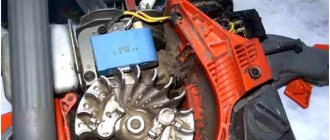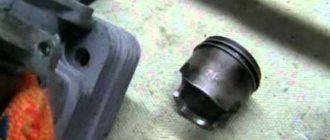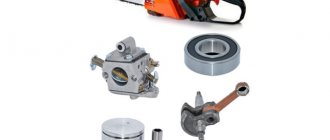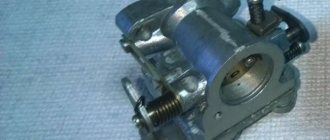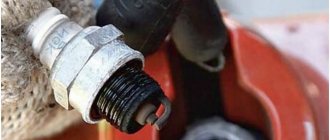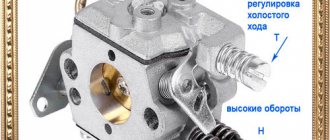Power system design
One of the components of the internal combustion engine is the fuel system. It is necessary for an uninterrupted supply of fuel to the engine. The system consists of a gas tank, fuel line, filters and carburetor. The latter doses gasoline to maintain a given crankshaft speed, depending on the operating modes of the walk-behind tractor. A gas tank is needed to store fuel reserves. Fuel lines connect all components to each other, and filters clean the fuel from foreign impurities.
The most complex and critical part in an internal combustion engine is the metering unit. The design of the carburetor installed on the walk-behind tractor allows the user to adjust the quality of the fuel mixture entering the engine. In general, the control system consists of the following:
- Float chamber. It contains the parts responsible for preparing the fuel mixture. Gasoline accumulates in the receiving glass, which affects the float. When the specified fuel level is reached, the latter, by pressing the shut-off needle, shuts off the fuel supply.
- Mixing chamber. It saturates the air entering the engine with fine gasoline dust. The latter is formed due to the rarefied atmosphere in the mixing chamber. The reduced pressure draws fuel from the float chamber, which, passing through the metering nozzle, is sprayed into the air stream.
- Throttle valve. This unit regulates the crankshaft speed. The damper closes the passage channel through which air enters the cylinder. The larger the cross-section, the faster the ICE output shaft will rotate. The position of the damper is adjusted using a steel cable attached to the handle of the walk-behind tractor.
- Idle speed regulator. Typically this is a metal or plastic screw that the throttle actuator rests on. Screwing in the regulator increases engine idle speed.
For your information!
Depending on the manufacturer and purpose of walk-behind tractors, their remote controls can be equipped with additional elements. But, regardless of this, all nodes work on the same principle.
Adjusting the walk-behind tractor carburetor - detailed description of the procedure
There are a number of signs indicating the need to adjust the built-in carburetor of a walk-behind tractor.
These include:
- a sharp drop in power of the walk-behind tractor;
- increasing the amount of exhaust gases produced;
- starting the walk-behind tractor engine followed by spontaneous shutdown;
- Unstable operation of the unit's engine at idle;
- rapid increase in the amount of fuel consumed.
There may be several reasons for all these malfunctions. Among them are the use of a walk-behind tractor under excessive loads on its mechanisms, as well as prolonged downtime of the unit without practical use. In any case, timely adjustment of the carburetor of the agricultural machine used will help solve these problems.
Adjusting the carburetor of an agricultural machine yourself is quite simple. Before making adjustments, you will need to start the engine and let it run for 5 minutes. After this, you need to directly adjust the carburetor on the walk-behind tractor.
The procedure is performed in the following sequence:
- After pre-warming, you need to turn off the engine and place the walk-behind tractor in a stationary position. Next, turn the screws that regulate full and low throttle until they stop, then turn them out 1.5 turns in the opposite direction;
- Next, you will need to start the engine again and warm it up - this should take at least 5 minutes;
- Then you will need to set the engine speed control lever to the lowest speed position - while the engine must be running;
- After this, you need to turn the throttle position adjustment screw to the position at which the walk-behind tractor engine will operate most stably;
- Next, you need to turn the carburetor low speed adjustment screw to the extreme maximum position;
- Then you will need to turn the throttle screw to the minimum position;
- The last two procedures should be performed until the engine starts running smoothly;
- After this, you need to set the engine speed control lever to the maximum gas position;
- At the end, you will need to turn the screw responsible for adjusting the maximum speed by 2.5 turns in different directions to check the stability of the engine. You can learn more about setting up the carburetor in the video.
After adjusting the walk-behind tractor carburetor with your own hands, you need to check the operation of the unit. If the engine starts to run smoothly and consumes less fuel, it means that the carburetor adjustment was done correctly.
Service
In order for agricultural machinery to work properly, it needs to be periodically inspected. Maintenance of the fuel unit comes down to cleaning the carburetor of the walk-behind tractor, checking the contamination of the air filter and gasoline fine cleaning elements. Considering that the remote control ensures the supply of fuel and, therefore, drives the motor-cultivator itself, you need to carefully monitor the condition of this mechanism, properly care for it and carry out repairs in a timely manner.
Constantly monitoring the condition of the remote control will prevent serious damage to sensitive components. In addition to adjusting the idle speed, regular cleaning of both the outer surface and internal cavities is carried out. During the inspection, the condition of moving parts and calibration jets is checked. The former are subject to abrasion when interacting with each other, while the latter become clogged with dirt. If deviations in geometric dimensions are found during disassembly, worn parts must be replaced.
"Motoblock master". Cleaning the carburetor of a walk-behind tractor
Frequent malfunctions in the operation of the power unit of a walk-behind tractor indicate the accumulation of blockages inside its carburetor. This fuel unit constantly interacts with engine oil, gasoline and air. They contain solid fractions, tar and small debris, which can be deposited on the walls of the carburetor chambers and inside the fuel channels. In this regard, the carburetor needs regular cleaning, especially if low-quality fuel is used to refuel the agricultural unit.
Before directly flushing the carburetor of the walk-behind tractor you are using, you need to remove the standard air filter and rinse it thoroughly in clean gasoline. After this, the part will need to be dried. The operator should also inspect and clean the spark plug. If a thick layer of carbon deposits has formed on its cap, this indicates oil leakage.
The further procedure should be as follows:
- First, you need to carefully remove the inoperative carburetor from the factory device and completely drain the remaining fuel from the standard metal float chamber;
- Next, you will need to inspect the built-in fuel fitting. If air does not pass through it, then the fitting must be blown out with compressed air from a purchased cylinder;
- Next, the operator must examine the condition of the float metal chamber and the “tongue” necessary to adjust the position of the float. The operator must check the level of the amount of refueling fuel that enters the chamber - its level must initially be no lower than 3.5 cm;
- After this, you will need to remove the needles responsible for setting low and full gas - this is necessary to completely flush the nozzle;
- Next, you need to unscrew the bolts and disconnect the standard upper part of the factory carburetor from the lower one. After this, the operator will be able to thoroughly rinse the built-in fuel supply valve;
- Then you need to blow out the nozzle with air from the cylinder. This and other carburetor elements should not be wiped with a lint-lined rag. Otherwise, the risk of damage to the chrome coating of the walls of the fuel unit will increase;
- After all the parts of the standard carburetor are completely dry, it can be assembled.
Immediately after installing the fuel unit, the operator must configure it and smoothly start the walk-behind tractor engine. Next, the user will need to check the operation of the node. If the built-in engine operates as stably as possible and does not make any extraneous sounds, it means that the standard carburetor was cleaned and adjusted correctly.
Sources:
https://o-motoblokah.ru/motobloki/karbyurator https://zemlyconsalt.ru/motobloki/regulirovka-karbyuratora-k45r-na-motobloke-agros.html https://minitraktor-pushkino.ru/motobloki/regulirovka- karbyuratora-k45r-na-motobloke-agros.html
Setting up the power system
A carburetor for a walk-behind tractor is a mechanism, the accuracy of which determines the performance of the equipment. “Floating” revolutions, torque dips, difficulties with starting are signs that the remote control needs to be adjusted. If the device has low idle speeds and periodically stalls, you need to slightly increase the crankshaft speed. To do this, screw in the adjusting screw under the throttle valve drive clockwise. If it is necessary to reduce the speed, the regulator, on the contrary, is unscrewed.
Cleaning the carburetor
To adjust the level, the carburetor on the walk-behind tractor is first completely cleaned of dirt. Before starting work, drain the fuel from the gas tank. To do this, unscrew the drain plug or remove the supply hose. Gasoline is poured into a clean canister or plastic container. Before refilling, it is advisable to pass the flammable liquid through a filter. After the fuel tank is empty, the supply hose is removed, dried and blown with compressed air.
The remote control is mounted directly on the cylinder head. To remove the metering mechanism, remove the air filter with the supply pipe. Then disconnect the throttle valve drive, unscrew the fasteners, and remove the carburetor from the seat. Cleaning the remote control:
- Disassemble the settling filter housing. At the bottom, unscrew the fixing bolt and remove the glass. Oily deposits are cleaned out from inside, everything is thoroughly wiped and dried.
- A float chamber is made in the lower part of the body. In its center is the main fuel jet, which can be unscrewed with a screwdriver. Underneath there is a small bushing, which is also removed. To remove the float with the closing needle, remove the support axis with pliers.
- The carburetor body (with pre-removed plastic parts) and jets are placed in acetone or white spirit for a day. The polymer components are washed with pure gasoline, cleaned with a soft brush, and then thoroughly dried.
- Soaked parts are cleaned of deposits with a rag, and the dosing holes are cleaned with a thin needle or wire.
- Assembly is performed in reverse order.
Carburetor adjustment
During the operation of gasoline-powered agricultural machinery, it is periodically necessary to make adjustments to all its components. It is necessary to adjust or clean the carburetor in a walk-behind tractor when the engine begins to malfunction or operate unstably. In equipment from different manufacturers, remote control adjustment is carried out individually. The sequence of the procedure, as well as the setting methods, depend on the model of the dosing mechanism.
"Cascade"
Low-power agricultural equipment is produced by the Perm Motors OJSC concern, which produces transmissions and gearboxes for helicopters. The high requirements for aircraft production contribute to the high-quality assembly of Cascade aircraft. The progress of adjusting the carburetors on a walk-behind tractor depends on the model of the power unit installed on it. The first representatives of the Cascade series were equipped with DM68 engines, which were produced by the Kaluga Machine-Building Plant. Subsequently, domestic engines began to be replaced with Chinese (Lifan) or Japanese (Honda) analogues.
For your information!
The power of walk-behind tractors of the "Cascade" series is approximately the same and ranges from 6 to 7 liters. With. However, the principles of regulation are similar for all.
Mostly, walk-behind tractors of the Cascade brand are equipped with engines with a KMB-5 remote control. Progress of regulation:
- Shut off the fuel supply from the gas tank.
- Flip out the pipe coming from the air filter to gain access to the throttle valve.
- Use the adjusting screw to set the gap between the wall of the fuel channel and the valve to approximately 2 mm.
- Reassemble everything in reverse order.
- Start the engine and use the adjusting screw to adjust the idle speed. The rotation speed should be stable, but as low as possible.
"Neva" MB-1, MB-2
Walk-behind tractors produced by Krasny Oktyabr JSC are classic models developed in 1984. Farmers value them for their unpretentious and high-torque engine, which is easy to maintain. A well-thought-out power system allows you to regulate the quality of the fuel mixture while the power unit is running. Progress:
Motoblock carburetor design
To properly adjust or clean the carburetor on a walk-behind tractor, you should first say a few words about its structure.
As you know, the carburetor in a walk-behind tractor is a certain part of the fuel system and performs the function of spraying fuel enriched to the required degree with oxygen. Basically, modern walk-behind tractors run on a gasoline engine (although there are alternative options - diesel and electric).
Externally, a carburetor for a walk-behind tractor looks like this:
